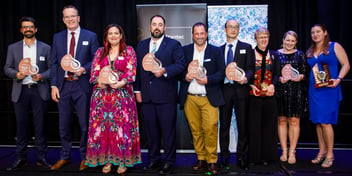How Seqwater protects South East Queensland’s drinking water catchments
Effective management of catchments for drinking water requires a range of measures, both regulatory and non-regulatory, in order to address risks to water quality.
For Seqwater, working in partnership with local catchment groups has been a successful way to protect and improve water quality in South East Queensland.
The challenge of managing open catchments
Seqwater is the Queensland Government statutory authority responsible for providing a safe, reliable and affordable bulk drinking water supply for 3.2 million people across South East Queensland.
It also manages recreation facilities, provides essential flood mitigation services, and provides water for irrigation to about 1200 farmers across seven water supply schemes.
“Seqwater is one of the few bulk water providers in Australia that manages large open catchments,” Seqwater Source Protection Planning Team Principal Greg Greene said ahead of his poster presentation at Ozwater'19 next week.
“Our catchments are core assets, however, Seqwater owns less than 5% of the 1.8 million hectares of catchment lands.”
While Seqwater uses every opportunity to influence the decisions of regulators, the organisation does not have jurisdiction or decision-making power over development that occurs in its drinking water catchments.
This means it relies heavily on voluntary mechanisms such as grants and advocacy to protect catchment land it doesn’t own.
Establishing community partnerships to protect water quality
Seqwater has developed a partnership model to help deliver its program of catchment improvement works and protect water quality.
This involves working with local governments, Landcare, Queensland’s Natural Resource Management bodies and conservation groups, and directly with landholders across the region.
“The partnership model centres around Seqwater as the funder and the partner organisation being the broker of the funding to local landholders,” Greene said.
“Both organisations work together to develop an agreed work plan based on priority works and locations in the drinking water catchments, informed by comprehensive planning and research.”
In 2018-19, Seqwater will invest almost $4 million, or about 40% of its catchment improvement investment budget, into these partnerships.
Seqwater uses partnership groups to deliver programs in a number of catchments, including:
- Riparian weed control
- Riparian revegetation
- Landslip remediation
- Erosion control
- Dairy practice improvement
- Onsite wastewater system upgrades
- Farm improvements such as revegetation and fencing
 Invasive species such as Cats Claw Creeper pose a significant threat to the health and resilience of riparian vegetation by overwhelming, smothering and killing riparian trees and destabilising waterways.
Invasive species such as Cats Claw Creeper pose a significant threat to the health and resilience of riparian vegetation by overwhelming, smothering and killing riparian trees and destabilising waterways.
“We consider this approach to be a highly effective investment model as much of the targeted investment is on private lands where Seqwater has little direct influence in achieving water quality management outcomes,” Greene said.
“Working with Landcare and conservation groups across the region allows Seqwater to tap into local knowledge through a reliable and trusted channel, better connect with the communities it serves, and leverage additional investment from other funding sources.”
Overcoming the challenges of a partnership delivery model
Working in partnership with other organisations isn’t without its challenges. For example, turnover of staff and the resulting loss of local knowledge about the environment and landholders can have a big impact on the planning and delivery of projects.
Greene said Seqwater has addressed this by establishing long-term partnership agreements that guarantee funding over a longer period of time.
“Seqwater recognises that job security for catchment group staff is fundamental to success,” he said.
Implementing programs on a yearly basis can also result in inconsistent and disjointed delivery and maintenance of works, with a high administrative burden. This has been overcome by extending programs from annual programs of works to multi-year programs.
Then there are regional priorities, which can differ according to individual needs, views and objectives.
“To ensure investments in catchment management activities provide maximum return, Seqwater now works extensively to support our catchment partners with guidance on priority locations and activities to ensure funding decisions are prudent, efficient and evidenced based,” Greene said.
“Catchment groups are a valuable source of planning information, and Seqwater now has the opportunity to work with a range of groups to access data, to share data and participate in planning practical solutions.”
For more on protecting drinking water catchments, don't miss Greg Greene's poster pitch presentation on the exhibition floor at Ozwater'19 in Melbourne. To view the full program and to register, click here.

